Fuel System -- Precaution |
| 1.BEFORE WORKING ON FUEL SYSTEM |
When disconnecting a fuel line, fuel will splash. So observe the following precautions:
Do not smoke or work near fire when handling the fuel system.
Keep gasoline away from rubber or leather parts.
Perform the "DISCHARGE FUEL SYSTEM PRESSURE" procedures below before disconnecting a fuel line to prevent gasoline from spilling out.
| 2.DISCHARGE FUEL SYSTEM PRESSURE |
- CAUTION:
- The "DISCHARGE FUEL SYSTEM PRESSURE" procedures must be performed before disconnecting any part of the fuel system.
- After performing the "DISCHARGE FUEL SYSTEM PRESSURE" procedures, pressure will remain in the fuel lines. When disconnecting a fuel line, cover it with a shop rag or a piece of cloth to prevent fuel from spraying or coming out.
Remove the console box (RAV4_ACA30 RM000001RHJ00GX.html).
Disconnect the connector.
Start the engine. After the engine has stopped, turn the ignition switch off.
- HINT:
- DTC P0171/P0172 (system too lean) may be set.
Check that the engine does not start.
Remove the fuel tank cap, and let the air out of the fuel tank.
Connect the connector.
Install the console box (RAV4_ACA30 RM000001RHG00HX.html).
 |
 |
| 3.FUEL LINE |
When disconnecting a high fuel pressure line, a large amount of gasoline will spray out, so observe the following procedures:
Discharge the fuel system pressure.
Disconnect the fuel pump main tube (RAV4_ACA30 RM0000017RJ02TX.html).
Drain the fuel remaining inside the fuel pump main tube.
To protect the disconnected fuel pump main tube from damage and contamination, cover it with a plastic bag.
Put a container under the connection part.
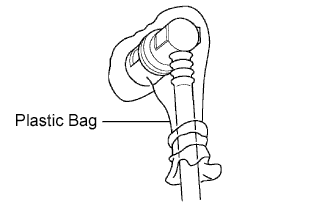
Observe the following precautions when disconnecting the fuel tube connectors (Quick type A):
Remove the No. 1 fuel pipe clamp from the tube connector.
With fuel hose connector cover: Disengage the lock claw by raising the cover as shown in the illustration.
Check that there is no dirt or other foreign objects on the pipe and around the connector before disconnecting them. Clean them if necessary.
Disconnect the connector from the pipe by hand.
When the connector and the pipe are stuck, push in and pull on the connector to release them. Pull the connector out of the pipe carefully.
Check that there is no dirt or other foreign objects on the sealing surface of the disconnected pipe. Clean it away if necessary.
Do not damage the disconnected pipe or connector, and prevent entry of foreign objects by covering them with plastic bags.
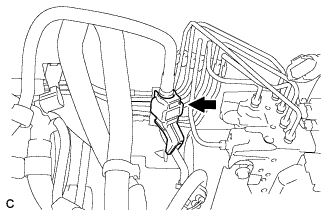

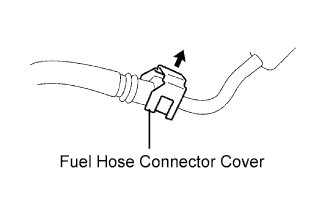
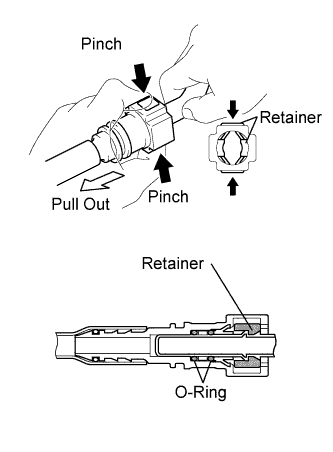

Observe the following precautions when connecting the fuel tube connectors (Quick Type A):
Check if there is any damage or foreign objects on the connecting parts of the pipes.
Line up the two parts of the pipes to be connected, and push them together until the connector makes a "click" sound. If the pipe is difficult to push into the connector, apply a small amount of clean engine oil to the tip of the pipe and reinsert it.
After connecting the pipes, check that the pipe and connector are securely connected by pulling on them.
With fuel hose connector cover: Engage the lock claws to the connector by pushing down on the cover.
Install the No. 1 fuel pipe clamp to the tube connector.
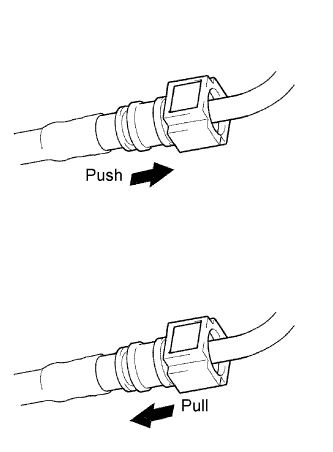



Observe the following precautions when disconnecting the fuel tube connector (Quick type B):
Before disconnecting the connector, clean off any dirt that may be present.
Pinch the tabs of the fuel tube retainer to disengage the 2 claws. Push the retainer down as shown in the illustration.
- HINT:
- Be sure to disconnect the connector by hand.
If the connector and pipe are stuck, hold the fuel pipe by hand and push and pull on the connector. Pull the two pipes apart to separate the connector.
If there is any dirt or any other foreign objects on the sealing surfaces of the disconnected pipes, clean them if necessary.
Do not damage the disconnected pipe or connector, and prevent entry of foreign objects by covering them with plastic bags.
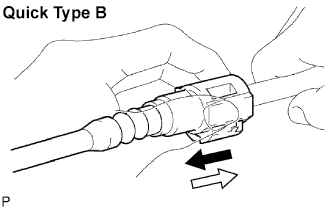

Observe the following precautions when connecting the fuel tube connector (Quick Type B):
Line up the two parts of the pipes to be connected, and fully push the fuel tube connector and pipe together until they are fully seated. Next, push the retainer into the connector until its claws lock. If the pipe is difficult to push in to the connector, apply a small amount of clean engine oil to the tip of the pipe and reinsert it.
After connecting the pipes, check that the pipe and connector are securely connected by pulling on them.
Check for fuel leaks.
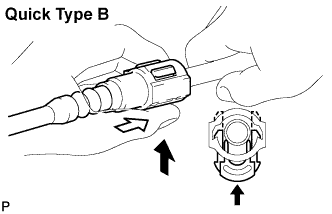
Observe the following precautions when handling a nylon tube:
- CAUTION:
- Do not twist the connection part of the nylon tube and the quick connector when connecting them.
- Do not bend or twist the nylon tube.
- Do not remove the EPDM protector on the outside of the nylon tube.
- Do not close the piping by bending the nylon tube.
 |
| 4.FUEL INJECTOR |
Observe the following precautions when removing and installing the fuel injectors:
Never reuse an O-ring.
When placing a new O-ring on the injector, do not damage the O-ring.
Coat a new O-ring with spindle oil or gasoline before installing it.
- NOTICE:
- Do not use engine oil, gear oil or brake fluid.
Install the injector to the delivery pipe and the lower intake manifold as shown in the illustration.
- NOTICE:
- Before installing the injector, be sure to apply appropriate lubricant or gasoline to the place where the delivery pipe or cylinder head contacts the injector O-rings.
 |
 |
| 5.FUEL SUCTION WITH PUMP ASSEMBLY |
Do not disconnect the tube shown in the illustration when disassembling the fuel suction with pump assembly.
- HINT:
- This tube is made of plastic and press-fitted to the positions indicated by the arrows. If the tube is forcibly removed, a proper seal cannot be secured.
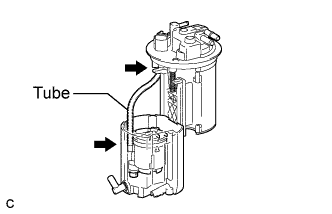 |
| 6.INSPECT FOR FUEL LEAK |
Check that there are no fuel leaks from the fuel system after doing any maintenance or repairs (RAV4_ACA30 RM000001IQZ02HX_01_0001.html).